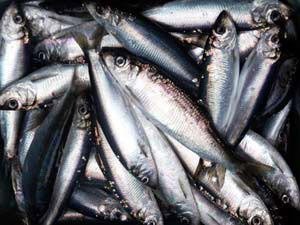Herring are the guests of honor at this year’s Tides of March marine education event at Eastsound Fire Hall, organized by Kwiaht and the volunteers of the Indian Island Marine Health Observatory. “Sea cucumber sandwiches, starfish cookies, peanut-worm butter brownies, puff-pastry anemones” and other unusual treats will accompany tea, talk, and a bounty of information about marine life on the Eastsound waterfront.
In addition to displays on the unusual fish, tide-pool life, plankton, eelgrass and birds of Indian Island, the Tides of March will also feature a slide show presentation by Russel Barsh exploring the life cycle of herring and their role in East Sound ecosystems. “If a herring egg isn’t eaten by a scoter, cormorant or gull within its first few days and lives to hatch,” Barsh says, “the tiny fish faces a gauntlet of predators that make survival to reproductive age a very long gamble.”
“Chinook salmon and marine birds seem to prefer herring over all other forage fish,” Barsh explains. “Herring spawning in the San Juan Islands declined sharply about 50 years ago, however, and has remained poor and sporadic, so the possibility of some herring recovery in Fishing Bay is very exciting.” Herring spawned in seaweed around Indian Island in 2011 and 2012.
The slide show will also share information on other seasonal visitors to Indian Island such as iridescent squid, bioluminescent jellyfish, and free-swimming sea slugs. Although many species arrive in huge numbers and depend on our bay to reproduce, they are often overlooked because they travel at night and leave quickly after mating or laying eggs. “Very stealthy slimy orgies” according to Barsh.
Dogfish also congregated in Fishing Bay to mate in the past, and were heavily fished by Native peoples as well as more recent residents of the island. Dogfish remains were found in archaeological sites around Eastsound, Barsh notes. Why they disappeared so completely even after the fishery ceased is something of a mystery. The Indian Island Marine Health Observatory team has never netted one.
Kwiaht asks for your help in reporting herring spawning anywhere in the islands this spring. “Any time from late March to early May you may see a lot of activity near the surface of the water in shallow vegetated bays,” Barsh says, “often lots of seabirds, and the water turns milky with herring milt.” You can email kwiaht@gmail.com or leave a message on the Indian Island MHO marine hotline 468-ITOX (468-4869).
The Tides of March will be celebrated at Eastsound Fire Hall from 4 to 6 p.m. on March 15 and admission is free.



